How and how to feed onions?
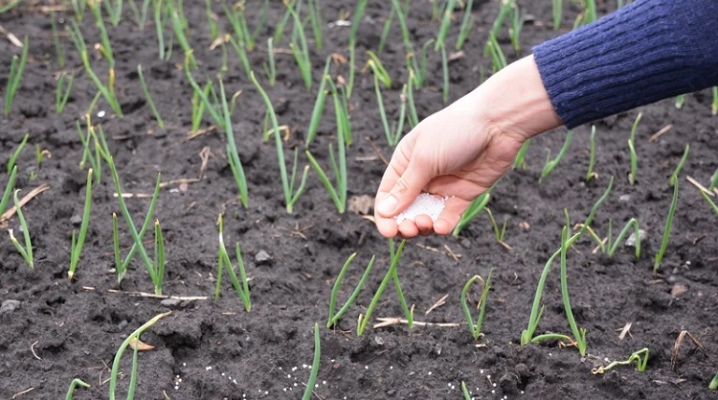
Onions are an unpretentious plant that can be found in almost every area. To increase the yield of this crop, it needs to be properly cared for. Particular attention should be paid to feeding the onion beds.
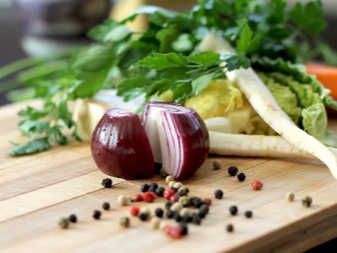

Fundamental rules
So that this procedure does not harm the plants, you need to adhere to certain rules.
- For work, it is recommended to choose a cool, cloudy day. In rainy or windy weather, you should not feed the beds.
- Fertilizers must be applied at the root. At the same time, the green part of the vegetable should not be affected. If the beds are large enough, fertilizer can be applied between the rows. In this case, it will definitely be possible to avoid burns.
- Before feeding onions, the soil should be watered abundantly with water. It shouldn't be too cold. This will protect the bow from scalding. In addition, the nutrients in the soil will be evenly distributed.
- After feeding, it is recommended to gently loosen the area. This is best done in the morning, because the soil dries quickly in spring and summer.
- It is worth feeding onions at least 2-3 times per season. This is especially important if the soil on the site is too poor.
Having familiarized yourself with these simple rules, you can begin to study the compositions used for feeding onions.
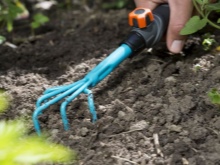
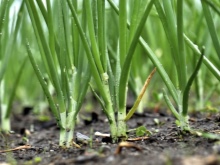
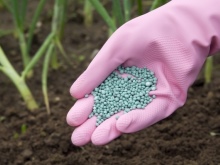
Fertilizer overview
The choice of fertilizers is now very large. Therefore, every gardener can choose the most suitable product for himself.
Organic
The use of organic fertilizing allows you to accelerate the natural growth of onions as quickly as possible. There are several basic fertilizer options that can be used to feed onion beds.
- Mullein. The work uses a liquid product that is pre-diluted in water. A glass of manure is added to a container with 10 liters of liquid. The product is stirred and sent to a dark place for several days. After that, the selected plants are treated with this agent.
- Chicken. This product is used in the same way as cow dung. Chicken droppings are placed in a deep container. If desired, this product can be replaced with a commercially available granular product. It is also diluted in water, but already in a ratio of 1 to 20. This top dressing is applied to a pre-moistened soil. Usually the product is poured between the rows. The chicken perfectly saturates the soil with nitrogen. Because of this, a large number of green shoots immediately appear on the site. This product is ideal for feeding plants such as sweet onions.
- Horse brew. This tool is used less often for feeding areas. But at the same time, it is no less effective than the previous ones. Harvest horse mash from rotted horse manure, as well as herbal infusion. In the work, you can use fresh nettles or any other weeds. The herb is placed in a barrel and then poured over with water. In this form, the product is left for three days. After that, the infusion is mixed with horse manure and warm water. For 1 liter of manure, 10 liters of water are used. It all gets mixed up. Further feeding is infused for another 2 days. Before use, the product must be diluted in a ratio of 1 to 10. After that, it can be taken out to the site and watered with it.
In its pure form, organic fertilizers should not be applied to the soil. This will result in burns. In addition, the heads will slow down their growth due to the fact that the plant will give all the nutrients to the green mass.
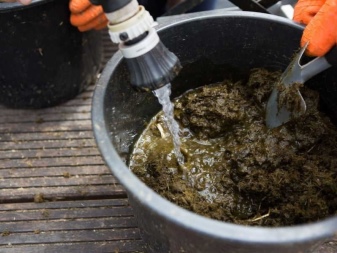
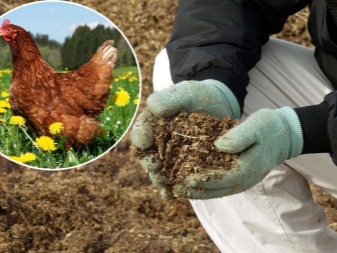
Mineral
For a good harvest, the soil can also be fed with purchased mineral fertilizers. They must be used very carefully, otherwise nitrates will gradually accumulate in vegetables. Mineral fertilizers can be applied in two main ways. In the first case, dry granules are diluted in water in advance. The resulting solution is applied to the soil in the morning or evening. It is best to feed onions in cloudy weather. On the second day after this procedure, the area is watered abundantly with water. This is done in order to rinse off product residues. In rainy weather, dry granules are simply scattered around the plants. The next day, the soil around them must be carefully loosened.
To feed the area where onions are grown, basic minerals are used.
- Nitrogen. This product is used at the very beginning of summer. Most often, gardeners add ammonium nitrate or urea to the soil.
- Potassium. Potash fertilizers are used in the onion head formation process. You can feed the site at this time with potassium humate or potassium salt.
- Phosphorus. To accelerate the growth of bulbs, gardeners use monophosphate, as well as superphosphate.
When using purchased drugs, it is important to ensure that they are not expired. Such products may well harm young plants.
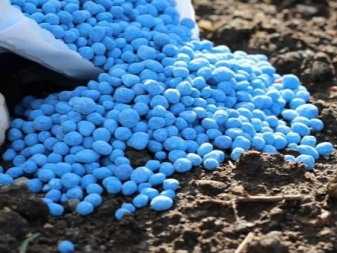
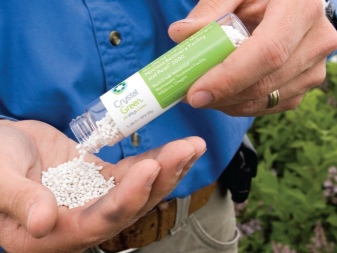
Complex
In addition to individual mineral fertilizers, there are also complex products on sale. Their use allows you to provide the plant with everything that they need at a certain stage of development. You can buy ready-made formulations at most gardening stores.
One of the most popular products used for plant nutrition is nitroammofosk. This drug is not only effective but also completely safe for plant health.
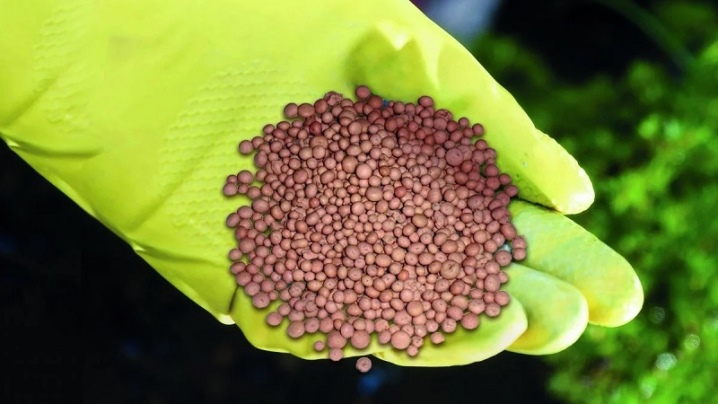
Folk remedies
Popular among gardeners and folk recipes.
- Herbal tincture. Any weed can be used to prepare this product. Usually gardeners add nettles or young dandelion foliage to the barrel. It is important to ensure that the selected plants do not have seeds. Otherwise, weeds can spread throughout the garden. The collected greens must be laid in a dense layer on the bottom of the barrel or bucket. Then it must be poured with boiling water. Then the product is sent to a dark place for several days. After a couple of days, the liquid will ferment. Watering the area with concentrated infusion is not worth it. It is usually diluted 1 to 1 and then used to water the area.
- Yeast. Another product that is often used to feed outdoor onions is high-quality yeast infusion. They should be fed onions that grow poorly or are slowly gaining green mass. Preparing the infusion is very simple. Add 100 grams of yeast, a tablespoon of sugar and a liter of water to the container. All this is thoroughly mixed. After a couple of hours, another 10 liters of warm water is added to the container. In this form, the product is left in a dark place for a day. The next day, you can start watering the site with this infusion. Some gardeners also add a small amount of dry ash to this product. This only enhances its properties.
- Bread. Suitable for feeding the beds and ordinary bread. Stale pieces can be used to prepare the solution. They must be cut into pieces and then filled with water. In this form, the container with bread and liquid must be left in a warm place for several days. You can speed up the fermentation process by adding a tablespoon of sugar to the container. The finished product is immediately used for watering the beds. First, you need to strain it, separating the liquid from the bread pulp. If this is not done, the crumbs will dry out in the beds and attract the attention of pests. It is worth remembering that yeast and bread dressing can only be used at temperatures above +20 degrees. Otherwise, there will be no benefit from them.
- Iodine. Feeding with iodine helps if the plant develops too slowly and the bulb does not form. A 5% solution is used to fertilize the site. For its preparation, 40 drops of the product are added to a 10-liter container with water. Watering agent can be used immediately after preparation.
- Ammonia. This product is usually used to treat the area in the event that onions begin to turn yellow. To prepare such a light top dressing, one and a half tablespoons of ammonia are diluted in 5 liters of water. This should be done outdoors. Immediately after preparation, the product can be used for spraying or watering the beds.
- Wood ash. This natural fertilizer is rich in a variety of nutrients that young onions need so much. The product promotes the rapid growth and development of plants, and also neutralizes the acidity of the soil. The product can be used dry. Wood ash helps not only to feed the site, but also to protect the onion from various pests. An ash solution can also be used to speed up onion growth. It is prepared as simply as possible. A glass of ash is diluted in 10 liters of boiling water. After that, the product is infused for 3-4 days. The resulting infusion can be sprayed immediately on the plants. Such feeding will increase the resistance of young onions to bad weather.
- Eggshell. You can also use dried shells in the garden. They begin to procure it in advance. The eggshells are washed and dried. Then it is thoroughly crushed. The resulting powder is applied to the soil. It can be used both dry and in solution. Such a product saturates the soil with nutrients, and also allows you to increase the yield of the site.
- Saline solution. This product is usually used if the green onion sets in the area start to turn yellow. Watering the beds with concentrated saline will quickly return the plant to its bright green color. In addition, the use of a saline solution helps protect the area from many diseases and insects. To prepare it, 200 grams of common salt is diluted in 10 liters of warm water. It is not recommended to exceed the dosage. The product must be used very carefully. The solution should be watered between the rows. The product should not come into contact with greens, as well as directly on the roots. In order for the onion to receive more nutrients, the beds must be well watered the day before feeding.
- Baking soda. Another unusual product that can be used on onion beds is plain baking soda. It improves the quality of plants and also helps them heal from many diseases.
- Boric acid. This effective remedy has been used for plant nutrition for a long time and is considered an excellent growth stimulant. The product, along with tar, increases the immunity of plants and protects them from the effects of many diseases. To fertilize the soil, boric acid must be diluted in a liquid. In the process, you should follow the instructions on the package. Before applying this top dressing, the site is well watered. This is done to prevent the plant from getting burned.
All of these products have worked well. Therefore, they can be used to feed onion beds.
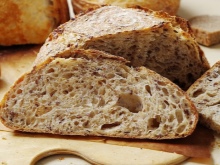
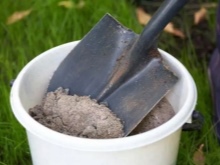
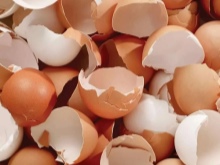
How to feed at different periods?
When applying fertilizers, the timing of the procedure plays an important role, because the needs of plants at different stages of development differ.
In the spring
In spring, onions are fed in several stages.
- When landing. First, the soil must be cleared of debris, and also thoroughly dug up. After that, organic fertilizers can be applied to it. If the soil on the site is too poor, mineral fertilizers are added to them. After such feeding, you can start planting onions. At this stage, it is worth using nitrogen fertilizing.
- After the first shoots appear. After 11-13 days, the first greenery will appear on the site.This process can be accelerated by feeding the area with nitrogen fertilizers on the 7th day of their growth. It is best to use regular urea for this purpose. The second feeding is especially important for those who grow green onions on a feather.
- Bulb formation. A couple of weeks after the first feeding, the site must be re-treated. At this time, no nitrogen supplements are used anymore. After all, fertilizers at this stage are applied in order to accelerate the growth of the bulb itself.
If you feed the beds three times during the season, the onions will grow well. This will increase not only its yield, but also resistance to the effects of diseases and pests.
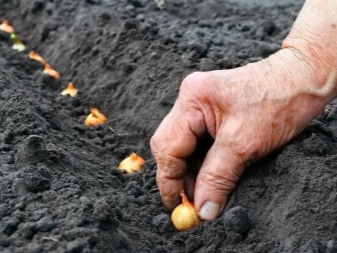
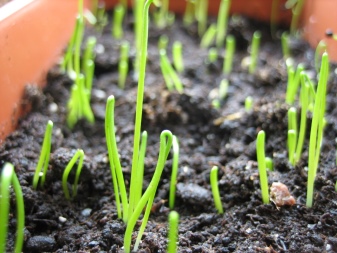
Summer
The last feeding of onions is carried out in June. It allows the heads to be made larger. At this stage, phosphate fertilizers are usually used. They are introduced into the soil in the first days of the month. Onions planted in May are fed a little later. At this stage, nitrogen substances are also not used. Their use will lead to the fact that the growth of the bulb will slow down.
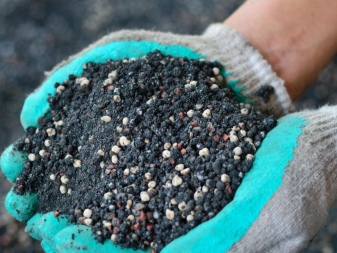
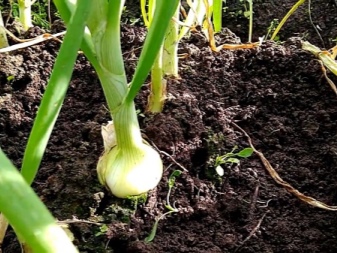
In autumn
Many gardeners prefer to fertilize the onion site in preparation for winter. In this case, the likelihood of getting a good harvest next year increases. In addition, gardeners have much more free time in the spring.
Before fertilizing in the fall, the soil is treated with a disinfectant. Usually, Bordeaux liquid or a solution of copper sulfate is used for this. Further, the soil is well dug up. In the process, humus is introduced into it. During the winter, nutrients are evenly distributed and make the soil as nutritious as possible. Such a top dressing is especially important for preparing the site where the onion will be grown for the first time.
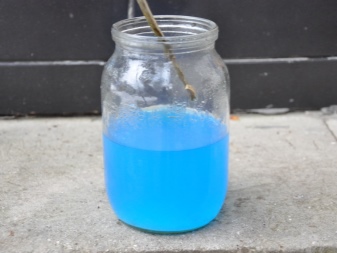

Useful Tips
Novice gardeners who want to increase the yield of onions in a short time can be helped by the advice of more experienced people.
- If the soil on the site is too acidic, this situation can be corrected by adding crushed chalk or wood ash to it.
- An area with too light or sandy soil is usually fed with a lot of fertilizer. But when planting onions in heavy soil, it is necessary, on the contrary, to reduce the dosage.
- If, in the process of feeding, fertilizers hit the green part of the leaf, it is advisable to immediately rinse it with water.
Proper care of the beds and regular feeding of the site is the key to a good harvest. If done correctly, great large onions can be grown even in a small area.

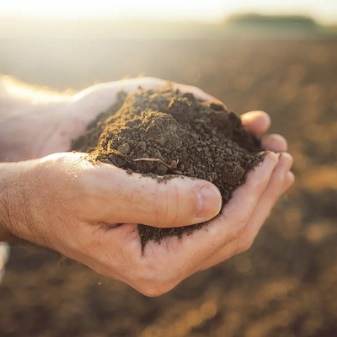













The comment was sent successfully.